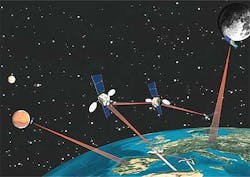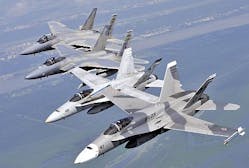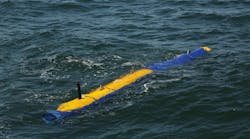ARLINGTON, Va., 6 Jan. 2013. Wireless data communications experts at the U.S. Defense Advanced Research Projects Agency (DARPA) are asking industry to develop a military data link able to transmit data at 100 gigabits per second within one radio frequency channel.
DARPA on Thursday issued a broad agency announcement (DARPA-BAA-13-15) for the 100 Gb/s RF Backbone (100G) program, which seeks innovative approaches for blending high-order modulation with spatial multiplexing to achieve spectral efficiencies greater than 20 bits-per-second-per hertz.
The goal of the 100G program is to create an airborne communications link with fiber-optic-equivalent capacity and long reach that can propagate through clouds and provide high availability.
The system will provide 100-gigabit-per-second capacity at ranges of 125 miles for air-to-air links and 62 miles for air-to-ground links from an aircraft flying at about 60,000 feet. The data link must be able to operate through clouds, rain, and fog while maintaining tactically relevant throughput and link ranges, DARPA researchers say.
DARPA will brief industry this Wednesday, 9 Jan., to provide information on the 100G program; promote additional discussion; address questions from potential proposers; provide a forum for potential proposers to present their capabilities for teaming opportunities; and conduct one-on-one sessions with the DARPA 100G program manager.
Briefings will be from 9 a.m.to 12:30 p.m. at System Planning Corp. (SPC) located at 3601 Wilson Blvd., 6th floor, in Arlington, Va. The official deadline for registering for the 100G briefings was last Thursday -- the day the program's solicitation was released -- but there still may be time to make arrangements for attending.
Companies interested in attending DARPA's 100G briefings should send an email to [email protected]. Include full name, organization, address, citizenship, telephone number, and e-mail address of attendees. Use "PROPOSERS DAY" in the subject line.
Attendees may request to present company overviews, discuss their technology expertise, and discuss teaming opportunities. Afternoon one-on-one sessions with Richard Ridgway, the DARPA 100G program manager, will be available.
The program's 100-gigabit-per-second airborne data links are to connect the major nodes of military networks, and to handle voice, video, Internet, and enterprise data flows.
Although the U.S. civil telecommunication infrastructure relies heavily on single-mode optical fiber as the data backbone, military communications cannot rely on a fixed infrastructure for deployed operations. Instead the military needs to project fiber-optic-equivalent capacity anywhere within the area of responsibility, DARPA researchers explain.
A logical approach is to use free-space optical (FSO) links using laser communications to project data at such speeds. FSO links have been shown to have fiber-optic-equivalent capacity at long ranges and are expected to play a significant role in the military’s airborne-based data backbone.
Still, today's FSO link technology cannot propagate through clouds, which are present 40 percent of the time in some regions and lead to unacceptable network availability, DARPA researchers point out. Instead, high-speed radio frequency (RF) links may be the best solution.
DARPA officials say they expect to award several contracts for the first phase of the 100G. about $18.3 million is available for this phase, which will be divided into three technical areas.
The first technical area involves high-order modulation at millimeter-wave frequencies, and will develop methods for generating, transmitting, receiving, and processing high-order modulation at millimeter-wave frequencies. The performers will build a transmitter and receiver.
The second technical area involves spatial multiplexing at millimeter-wave frequencies to reduce transmit power. The third technical area involves proof-of-concept demonstrations and other tests key to the operation of the 100G system.
Companies interested in bidding should respond to the first and second technical areas no later than 19 Feb., while those bidding on the third technical area should respond by 21 March. DARPA asks bidders to send abstracts by 31 Jan.
Bidders should send abstracts and proposals to DARPA via the agency's Strategic Technology Office (STO) BAA Website, which is online at https://stobaa.sainc.com.
Email questions or concerns to DARPA at [email protected]. More information is online at https://www.fbo.gov/spg/ODA/DARPA/CMO/DARPA-BAA-13-15/listing.html.




